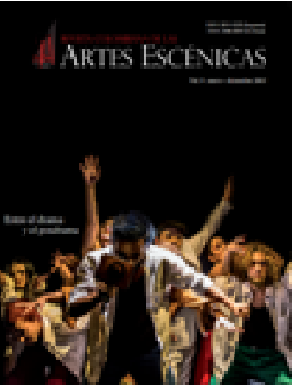Authors
Abstract
The aim of this article is to study the treatment of the collective dimension of the audience in performing arts following the social twist occurred since the year 2000. Taking as starting point the perspective of theater as representation, action and encounter, the article begins discussing the concept of “post-dramatic theater“ in relation to “post-spectacular theater”. Then, it continues with an analysis of the type of participation that is proposed to the audience in works where the actor leaves his central place to identify himself with the mediator role, opening a space where viewers are invited to place themselves. Finally, it concludes with the word as a form of action carried out by the audience. The scene becomes a space where activities such as listening, reading, thinking or being, regain their collective dimension as social tools.
References
Arendt, H. (2005). La condición humana [1958].(Trad. R. Gil Novales). Barcelona: Paidós.
Asencio, S. (2014, septiembre 22). Delimitar un espacio y llegar lo más hondo posible. Societat Doctor Alonso.
Recuperado de http://www.tea-tron.com/societatdoctoralonso/blog/2014/09/22/delimitar-un-espacio-yllegar-lo-mas-hondo-posible/
Bauman, Z. (2004). La sociedad sitiada [2002].(Trad. M. Rosenberg y E. Zaidenwerg).Buenos Aires: Fondo de Cultura Económica.
Borralho, A., & Galante, J. (2015). Aller mourir plus loin. En Saison 2015-2016, Humain Trop Humain, CDN, Montepellier.
Brooke, M., & Casado, R. (2013). Y si el acontecimiento somos nosotros. En Ó.Cornago (Coord.). Manual de emergencia para prácticas escénicas. Comunidad y economías de la precariedad. Madrid: Con tinta me tienes.
Eiermann, A. (2009). Postspektakuläres Theater. Die Alterität der Aufführung und die Entgrenzung der Künste. Bielefeld: Transcript.
Eiermann, A. (2012). Teatro postespectacular. La alteridad de la representación y la disolución de las fronteras entre las artes.(Trad. Micaela van Muylem). Telón de Fondo.Revista de teoría y crítica teatral, 16. Recuperado de file:///C:/Users/Liliana/Downloads/teatro-postespectacular-la-alteridad-dela-representacion-y-la-disolucion-de-lasfronteras-entre-las-artes.pdf
Lehmann, H.-T. (2013). Teatro posdramático [1999]. (Trad. D. González). Murcia: Cendeac.
Mroué, R. (s.f.). It´s a total experiment. There are no limits. Schau ins blau. Recuperado de http://archiv.schauinsblau.de/rabihmroue/
bild_ton/its-a-total-experiment-there-are-nolimits/Sikorsky, E. (2010, 11 de noviembre). Xavier Le Roy: Low pieces. Bellyflop Magazine.
Recuperado de http://bellyflopmag.com/reviews/xavier-le-roy-low-pieces.
Soto, I. (2012, 28 de junio). Xavier Le Roy: “Pensar es una experiencia corporal”. Revista Ñ. Clarín. Suplemento cultural. Recuperado
de http://www.revistaenie.clarin.com/escenarios/teatro/Xavier-Le-Roy-Lowpieces_0_727127526.html
Virno, P. (2004). Cuando el verbo se hace carne. Lenguaje y naturaleza humana [2003]. (Trad. E.Sadier). Buenos Aires: Cactus/Tinta Limón.

 PDF (Español)
PDF (Español)
 FLIP
FLIP









